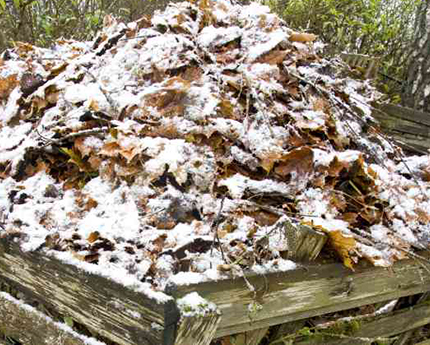
COLD WEATHER COMPOSTING

Keeping the Compost Cooking Through Winter in Any Region
The sight of steam rising from a compost pile on a cold winter day is sure to warm the heart of every gardener. It’s a sign that when spring comes, you’ll have a batch of fresh compost to use for getting seeds and transplants off to a healthy start in your garden. Frigid weather outside can slow the decomposition process, but you can maintain an essential core of heat, which indicates that crucial microbial activity is occurring inside the pile. “The outside layer of the pile will be ambient temperature,” says Mark Van Horn, a researcher at the University of California-Davis, “but if things are right, the inside of the pile will be hot.” These hints from the experts we spoke to will help keep your compost cooking through winter in any region.
Microbe Management
Even in winter, a compost pile is alive, an ecosystem in flux. “Microorganisms such as bacteria, fungi, and actinomycetes account for most of the decomposition activity in a compost pile,” explains Dave Wilson, research agronomist at the Rodale Institute. The microbial action in decomposition is exothermic, which means that heat is a by-product of the chemical process of breaking down the material.
The microbes’ metabolism slows down as the temperature dips, which explains why food keeps in a refrigerator or freezer. In winter, your goal is to create an ideal habitat for microbes. Think of it as “micro-husbandry.”
Feeding. Microbes need a balanced diet, a mix of carbon and nitrogen rich materials (also known as “browns” and “greens”). Your kitchen scraps, such as vegetable and fruit peelings, coffee grounds, and houseplant trimmings are handy sources of nitrogen-rich ingredients. You can also compost eggshells and even domestic waste products like shredded newspaper. Manures from chickens or rabbits are loaded with heat-generating nitrogen. If you don’t have access to that, you can add alfalfa pellets (sold as rabbit food) or blood meal to give your pile a nitrogen boost.
For carbon-rich ingredients, use straw, fallen leaves, shredded newspaper, or sawdust. You can toss in small amounts of ashes from your fireplace or woodstove, which also enhance the calcium, phosphorus, and potassium content of your finished compost.
Particle size. Help chilly, sluggish microbes by doing some of the work for them—chop or shred both browns and greens before adding them to the pile. Tamara Listiak of the Texas A & M Cooperative Extension recommends shredding the material into pieces smaller than 2 inches. The pile heats up uniformly, and the small particles form a kind of mat that shields the pile’s warm core from outside temperature extremes, she explains.
Layering. During warm periods, you can just add ingredients to your compost pile as they become available. But in the cold season, take time to add layers of brown ingredients to your green materials. The layers help insulate your pile, trapping heat and gases inside.
Moisture. Winter winds and low humidity can suck the moisture out of your compost pile. The microbes need moisture to survive. During warm spells, water the pile. Leave it damp, but not soaking.
Fresh air. In warm weather, frequent turning is the best way to keep microbes well supplied with oxygen. But in winter, you want to cause as little disturbance as possible to the layer of insulation. Wait until spring to turn the pile.
Outside Insulators
While your pile is cooking inside, you can boost its external temperature, too.
- Solar power. Where winter is long and frigid, site your compost pile in full sun.
- Snowbound. A long-lasting blanket of snow insulates compost from deep freezes, but it can inhibit thawing. Leave it on piles to which you are not adding new material; scrape it off when you put on a fresh layer.
- Tarp trap. Covering your pile with a canvas or plastic tarp prevents heat and moisture loss more effectively than a layer of snow. Just remember to add water to the pile regularly when you’ve shielded it from natural sources.
- Bale out. Pack straw bales around your bin or pile for another layer of protection from wind and cold.
- In the pits. Dig a trench and fill it with compost ingredients to use the ground’s stored heat as an insulating buffer.
By Genevieve Slocum

